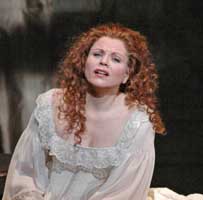Key Word Search
Multi-Field Search
Browse
Repertory Report
Performers Report
Contacts
Met Opera Website
Metropolitan Opera Premiere, New Production
Rodelinda
Metropolitan Opera House, Thu, December 2, 2004
Debut : Harry Bicket, Kobie van Rensburg, Zachary Vail Elkind, Stephen Wadsworth, Thomas Lynch, Peter Kaczorowski
Rodelinda (1)
George Frideric Handel | Nicola Francesco Haym
- Rodelinda
- Renée Fleming
- Grimoaldo
- Kobie van Rensburg [Debut]
- Garibaldo
- John Relyea
- Eduige
- Stephanie Blythe
- Bertarido
- David Daniels
- Unulfo
- Bejun Mehta
- Flavio
- Zachary Vail Elkind [Debut]
- Conductor
- Harry Bicket [Debut]
- Production
- Stephen Wadsworth [Debut]
- Set Designer
- Thomas Lynch [Debut]
- Costume Designer
- Martin Pakledinaz
- Lighting Designer
- Peter Kaczorowski [Debut]
- Composer
- George Frideric Handel
Continuo:
Dennis Giauque, Harpsichord
David Heiss, Cello
Daniel Swenberg, Theorbo and LuteProduction photos of Rodelinda by Marty Sohl / Metropolitan Opera.
FUNDING:
The production a gift from John Van Meter.
Additional production gifts from Mr. and Mrs. Sid R. Bass, and the Hermione Foundation.
Review 1:
Review of David J. Baker in the February 2005 issue of OPERA NEWS
Stephen Wadsworth's handsome production of "Rodelinda" is sure to win Met audiences to this powerful work.
The Metropolitan Opera premiere production of Handel's "Rodelinda" (December 2) was a successful compromise, a blending of Baroque stylistics with the house's traditional performance and production values. Some standards suffered, but everyone gained at least something.
English conductor Harry Bicket, a practiced Handelian in his house debut, made the composer's melodies sound both historically distant and dramatically compelling. He scaled down the orchestra, with some of the strings employing old-style bows, and added recorders and a lute for period flavoring. The conductor found energy, personality and specific emotional impact in each of the twenty-seven solo arias that (with just two ensembles) made up his slightly cut version of the established score. Even without great rhythmic flexibility, the orchestra's playing sustained unusual vividness and beauty.
The casting, a mix of generalists and specialists, demonstrated two basic problems in Handel performance practice. First, the singers ranged widely in their ability to execute, let alone embellish, the complex da capo arias. Second, in their approach to dramatic vocal expression, they formed two separate camps.
In the richly written title role, Renée Fleming took the greatest liberties, offering an intense demonstration of the singer as Method actor. The listener could admire her fierce commitment, the breathless speed in fioriture, the sacrifice of tone quality to drama in her harsh recitatives; all this was matched by her responsive body language and mobility.
Yet it was difficult to accept quite so many vocal tics: pinched, oblique attack; bent notes even in cantilena such as the lovely aria "Ritorna, o caro," which she has recorded with less fuss. Her trilling, mesa di voce and some dazzling top notes showed that she is capable of more even-handed mastery
The role of Grimoaldo, the neurotic would-be villain, was sung with similar
histrionics, and some blurring of niceties, by a newcomer to the company, tenor Kobie van Rensburg. In the final part of the fascinating hallucinatory Act III aria, he relied on non-musical expressive means, deliberately distorting tone quality, breaking up notes and phrases. Bass John Relyea left no doubts as to the real villainy of Garibaldi, again at some cost to musical refinement.
In contrast to these aggressive tactics, countertenor David Daniels as the deposed monarch Bertarido gave a lesson in Handelian style without any loss of character delineation or dramatic conviction. He traced the elaborate vocal lines with smoothness and precision, despite slightly limited dynamic range and occasional hollow timbre. Each of his arias, such as the rousing "Vivi, tiranno" in the final scene, was an artistic, emotional experience.
In the lesser countertenor part of Unulfo (with a mere three arias), Bejun Mehta made a successful impression, thanks to a vibrant stage personality, skillful fulfillment of most technical demands and a tone of natural and consistent richness. Stephanie Blythe's opulent contralto timbre was both stylish and forceful in conveying the shifting emotions of the semi-villainess Eduige.
Recent "Rodelinda" productions have moved the action to Civil War and Nazi-era settings. But Stephen Wadsworth, in his first Met assignment, showed his practiced hand with Handel while toeing a more judicious line. He retained the Lombard locale but advanced the action to Handel's own time, with help from Martin Pakledinaz's flattering costumes.
Wadsworth succeeded in imposing a natural dramatic flow, inventing logical and musically appropriate movement, despite a few unnecessary details (the heroine's groans and handcuff, in Act I) and the potential distractions of a horse and child actor onstage.
He avoids a formulaic succession of entrances and exits, instead keeping characters visible almost continually, as participants or at least observers. This device also helps cushion the changes of heart by both Eduige and Grimoaldo, which could seem comically abrupt if we had not seen them watching the effects of their actions on others.
Thomas Lynch's picture-postcard sets, warmly and dramatically lighted by Peter Kaczorowski (both in company debuts), revolved, rose and descended to accommodate the narrative, sometimes to striking effect. The richly colored courtyard (rather than the libretto's cypress grove) that holds Bertarido's presumed tomb ascends in Act III to reveal him in prison on the stage just below it, an ironic visual pun on various forms of burial.
The handsome production is sure to win Met audiences to this powerful, melodious work. It should also help advance the company's previously hesitant relationship with Handel.
Search by season: 2004-05
Search by title: Rodelinda,
Met careers
- Harry Bicket [Conductor]
- Renée Fleming [Rodelinda]
- Kobie van Rensburg [Grimoaldo]
- John Relyea [Garibaldo]
- Stephanie Blythe [Eduige]
- David Daniels [Bertarido]
- Bejun Mehta [Unulfo]
- Zachary Vail Elkind [Flavio]
- Stephen Wadsworth [Production]
- Thomas Lynch [Set Designer]
- Martin Pakledinaz [Costume Designer]
- Peter Kaczorowski [Lighting Designer]
- George Frideric Handel [Composer]
